vue3组合式API之setup()介绍与reactive()函数的使用
Posted 初映CY的前说
tags:
篇首语:本文由小常识网(cha138.com)小编为大家整理,主要介绍了vue3组合式API之setup()介绍与reactive()函数的使用相关的知识,希望对你有一定的参考价值。

==>😉博主:初映CY的前说(前端领域) ,📒本文核心:setup()概念、 reactive()的使用
【前言】vue3作为vue2的升级版,有着很多的新特性,其中就包括了组合式API,也就是是 Composition API。学习组合式API有什么优点呢?之前的vue2中结构不是挺不错的吗?那么接下来的事件,我将带着你从浅到深分析为什么我们需要学习组合式API以及我们的setup()函数作为入口函数的一个基本的使用方式。
目录
⭐一、组合式API对比vue2项目结构
在vue2当中
-
1.优点:易于学习和使用,写代码的位置已经约定好。
-
2.缺点:对于大型项目,不利于代码的复用、不利于管理和维护。
-
3.解释:同一功能的数据和业务逻辑分散在同一个文件的 N 个地方,随着业务复杂度的上升,我们需要经常在类似于data()以及methods中进行来回的处理
在vue3当中
-
1.优点:可以把同一功能的数据和业务逻辑组织到一起,方便复用和维护。
-
2.缺点:需要有良好的代码组织和拆分能力,相对没有 Vue2 容易上手。
-
3.解释:注意:为了能让大家较好的过渡到 Vue3.0 版本,目前也是支持 Vue2.x 选项 API 的写法。
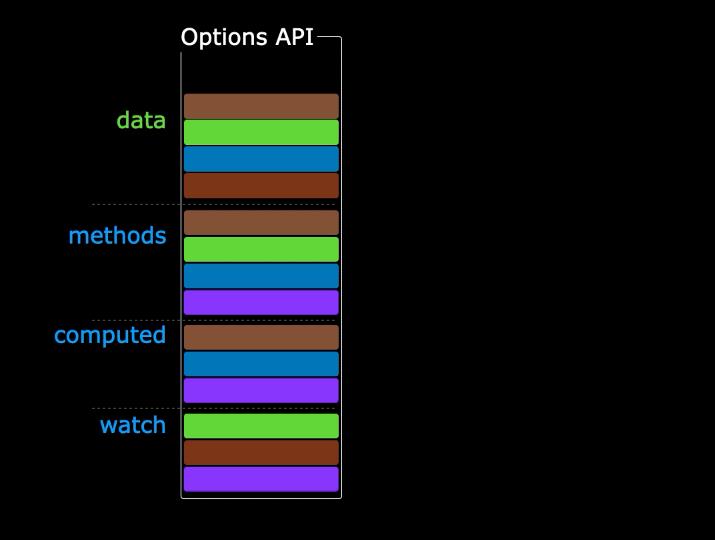
⭐二、setup()函数的使用
2.1setup()函数的基础概念
Vue3 中的 setup() 是 Vue3 新增的组件配置项,用于替代 Vue2 中的 data()、methods()、computed() 等配置项。setup() 提供了更简洁的编写方式,且能够更好地利用 Vue3 提供的 Composition API。setup() 函数接受两个参数,分别是 props 和 context。其中,props 是组件接收的属性值,context 包含了一些组件的配置信息。
-
1.是什么:setup 是 Vue3 中新增的组件配置项,作为组合 API 的入口函数。
-
2.执行时机:实例创建前调用,甚至早于 Vue2 中的 beforeCreate。
-
3.注意点:由于执行 setup 的时候实例还没有 created,所以在 setup 中是不能直接使用 data 和 methods 中的数据的,所以 Vue3 setup 中的 this 也被绑定为了 undefined。
虽然 Vue2 中的 data 和 methods 配置项虽然在 Vue3 中也能使用,但不建议了,建议数据和方法都写在 setup 函数中,并通过 return 进行返回可在模版中直接使用(一般情况下 setup 不能为异步函数)。
2.2.setup()初体验
App.vue
<template>
<h1 @click="say()"> msg </h1>
</template>
<script>
export default
setup()
const msg = 'Hello Vue3'
const say = () =>
console.log(msg)
return msg, say
,
</script>
效果查看:
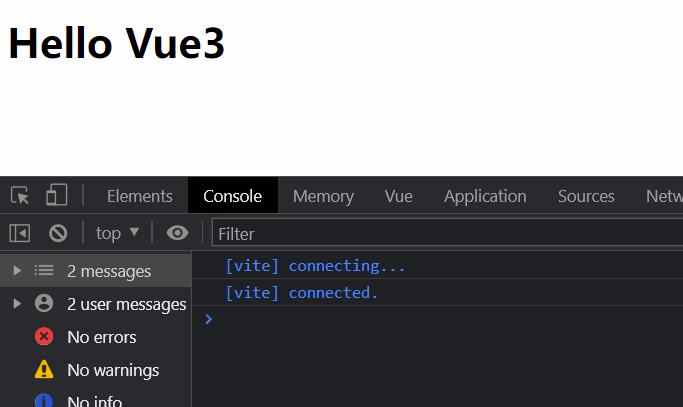
注意:酷似于vue2中的data()与methods都是需要写在return才可作为结果进行调用。
【小小面试题补充】setup 中 return 的一定只能是一个对象吗?(setup 也可以返回一个渲染函数)
App.vue
<script>
import h from 'vue'
export default
name: 'App',
setup()
return () => h('h2', 'Hello Vue3')
,
</script>
控制台则是打印出了h2标签的Hello Vue3。
2.3.reactive()函数
使用 reactive 函数包装数组为响应式数据。reactive 是一个函数,用来将普通对象/数组包装成响应式式数据使用,无法直接处理基本数据类型(因为它是基于 Proxy 的,而 Proxy 只能代理的是对象)。
比如当我有一个需求:点击删除当前行信息
App.vue
<template>
<ul>
<li v-for="(item, index) in arr" :key="item" @click="removeItem(index)"> item </li>
</ul>
</template>
<script>
export default
name: 'App',
setup()
const arr = ['a', 'b', 'c']
const removeItem = (index) =>
arr.splice(index, 1)
return
arr,
removeItem,
,
</script>
通过vueTools查看,我点击过后数据是被删除了,但页面上并没有事实的渲染出来
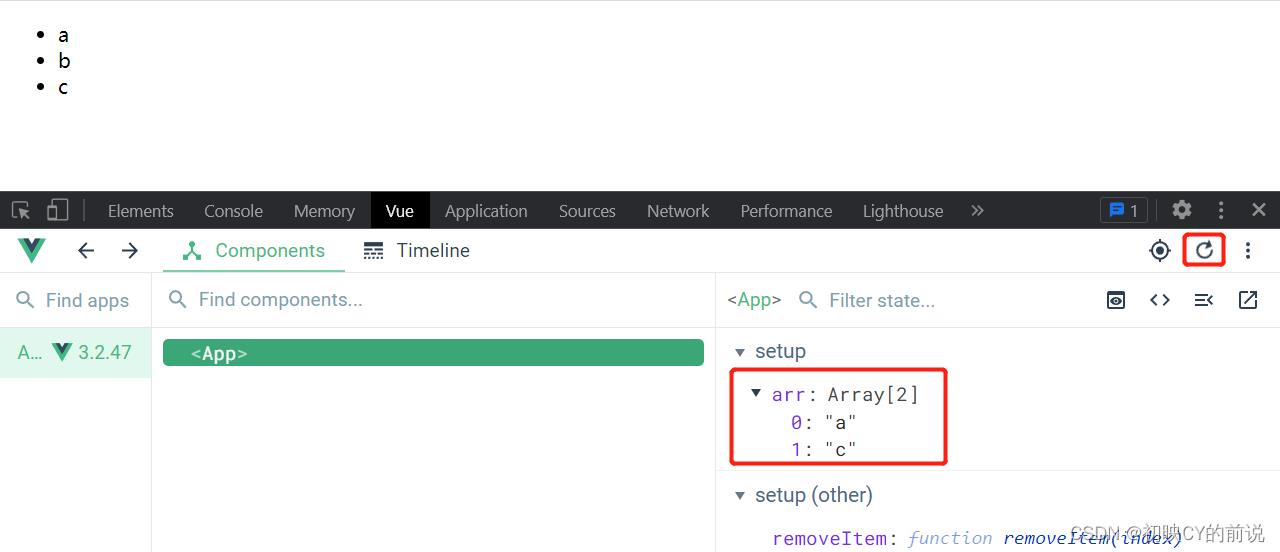
此时,使用 reactive()包装数组使变成响应式数据,别忘了导入
<template>
<ul>
<li v-for="(item, index) in arr" :key="item" @click="removeItem(index)"> item </li>
</ul>
</template>
<script>
import reactive from 'vue'
export default
name: 'App',
setup()
const arr = reactive(['a', 'b', 'c'])
const removeItem = (index) =>
arr.splice(index, 1)
return
arr,
removeItem,
,
</script>
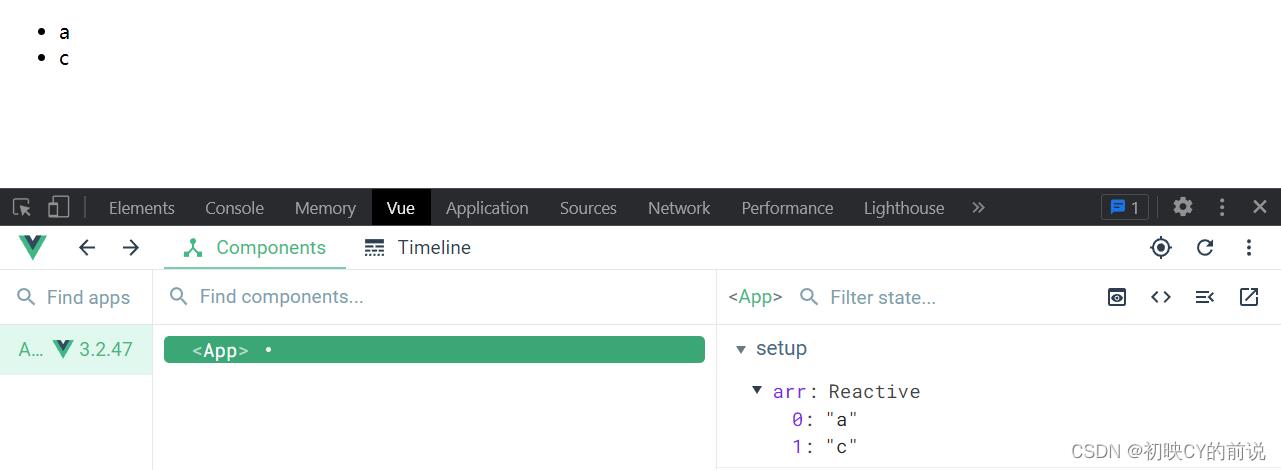
此刻页面也就具有了响应式,点击时删除,页面则是响应式的
同理:我们用reactive()来包裹我们的对象来使用
<template>
<form @submit.prevent="handleSubmit">
<input type="text" v-model="user.id" />
<input type="text" v-model="user.name" />
<input type="submit" />
</form>
<ul>
<li v-for="(item, index) in state.arr" :key="item.id" @click="removeItem(index)"> item.name </li>
</ul>
</template>
<script>
import reactive from 'vue'
export default
name: 'App',
setup()
const state = reactive(
arr: [
id: 0,
name: 'ifer',
,
id: 1,
name: 'elser',
,
id: 2,
name: 'xxx',
,
],
)
const removeItem = (index) =>
// 默认是递归监听的,对象里面任何一个数据的变化都是响应式的
state.arr.splice(index, 1)
const user = reactive(
id: '',
name: '',
)
const handleSubmit = () =>
state.arr.push(
id: user.id,
name: user.name,
)
user.id = ''
user.name = ''
return
state,
removeItem,
user,
handleSubmit,
,
</script>

上述代码的解意:
我定义了输入框,定义了删除、添加事件的操作,通过v-model打到双向绑定数据来完成对我的数据进行增加与删除。
到目前你是不是对setup()的使用有了更加清晰的认识呢?下面再来简化一下我们的写法。
2.3.1reactive()的进一步抽离
优化:将同一功能的数据和业务逻辑抽离为一个函数,代码更易读,更容易复用。
<template>
<form @submit.prevent="handleSubmit">
<input type="text" v-model="user.id" />
<input type="text" v-model="user.name" />
<input type="submit" />
</form>
<ul>
<li v-for="(item, index) in state.arr" :key="item.id" @click="removeItem(index)"> item.name </li>
</ul>
</template>
<script>
import reactive from 'vue'
function useRemoveItem()
const state = reactive(
arr: [
id: 0,
name: 'ifer',
,
id: 1,
name: 'elser',
,
id: 2,
name: 'xxx',
,
],
)
const removeItem = (index) =>
state.arr.splice(index, 1)
return state, removeItem
function useAddItem(state)
const user = reactive(
id: '',
name: '',
)
const handleSubmit = () =>
state.arr.push(
id: user.id,
name: user.name,
)
user.id = ''
user.name = ''
return
user,
handleSubmit,
export default
name: 'App',
setup()
const state, removeItem = useRemoveItem()
const user, handleSubmit = useAddItem(state)
return
state,
removeItem,
user,
handleSubmit,
,
</script>
将方法抽离出来,用类似于导入的方式进行一个抽离,将数据与方法放在一起,便于我们的统一管理。
2.3.2reactive()再进行进一步文件拆分并且引入
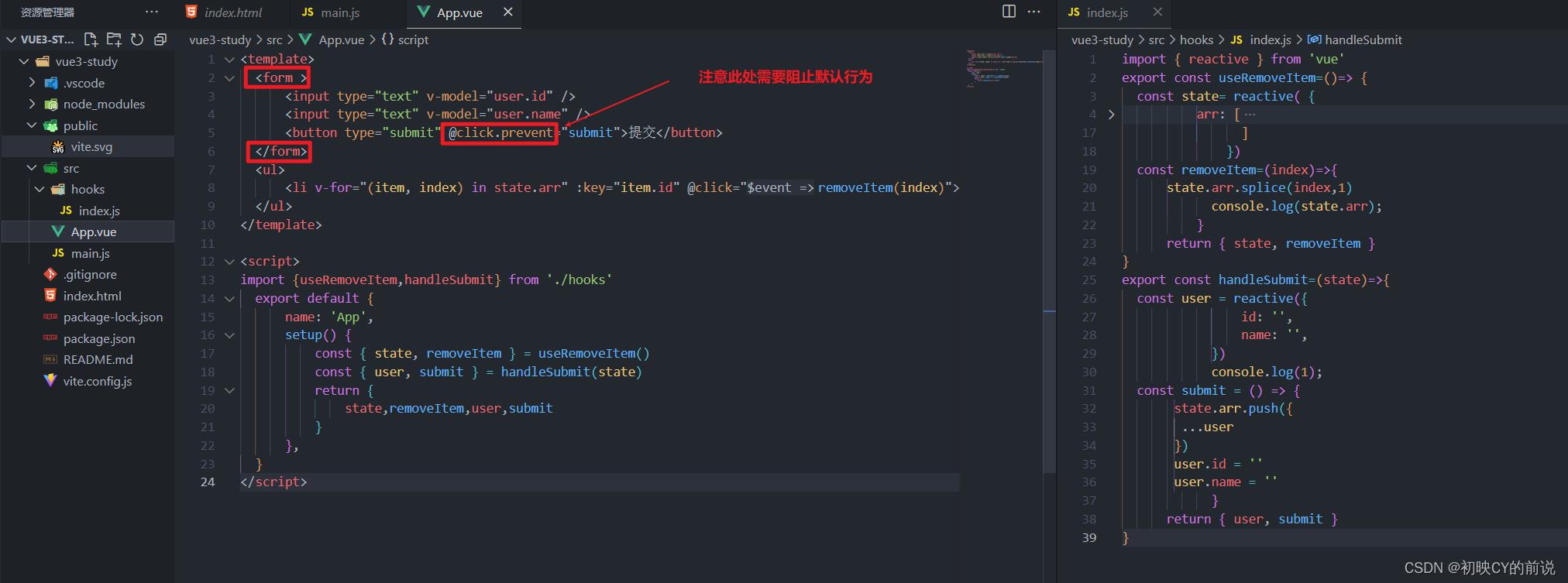
App.vue
<template>
<form >
<input type="text" v-model="user.id" />
<input type="text" v-model="user.name" />
<button type="submit" @click.prevent="submit">提交</button>
</form>
<ul>
<li v-for="(item, index) in state.arr" :key="item.id" @click="removeItem(index)"> item.name </li>
</ul>
</template>
<script>
import useRemoveItem,handleSubmit from './hooks'
export default
name: 'App',
setup()
const state, removeItem = useRemoveItem()
const user, submit = handleSubmit(state)
return
state,removeItem,user,submit
,
</script>
hooks/index.js
import reactive from 'vue'
export const useRemoveItem=()=>
const state= reactive(
arr: [
id: 0,
name: 'ifer',
,
id: 1,
name: 'elser',
,
id: 2,
name: 'xxx',
,
]
)
const removeItem=(index)=>
state.arr.splice(index,1)
console.log(state.arr);
return state, removeItem
export const handleSubmit=(state)=>
const user = reactive(
id: '',
name: '',
)
console.log(1);
const submit = () =>
state.arr.push(
...user
)
user.id = ''
user.name = ''
return user, submit
至此本文结束,愿你有所收获!
期待大家的关注与支持! 你的肯定是我更新的最大动力!!!
vue3中的setup
参考技术A setup :组合api的入口函数 所有的组合api都学在setup中使用,它运行在beforeCreate之前例:<script setup>
setup方法使用在script标签内 就不需要return数据以及方法了(这种方法一旦使用就不再有选项式api了)
const a = 1 (这样声明的数据没有响应式,就是不能和页面双向绑定)
const num = ref(0) (ref是一个声明响应式数据及方法,它是由reactive封装过来的,他的值其实在value中,所以我们使用及赋值时都要使用value属性,ref当前版本下可以声明所有的数据,包括基本数据类型,以及引用数据类型(复杂数据类型))
错误写法 :components :,beforeCreate() (这种用法下 导入的组件会自动注册无需手动注册)
</script>
第二种方法,例:<script>
import reactive,toRefs from 'vue' (用到啥引入啥)
setup()
const state= reactive (name: ‘张三’,age:14,id:1314)(reactive我们用来声明一个包含复杂结构的对象数据)
return ...toRefs(state) (用到的方法及数据等等需要return出来)
</script>
以上是关于vue3组合式API之setup()介绍与reactive()函数的使用的主要内容,如果未能解决你的问题,请参考以下文章